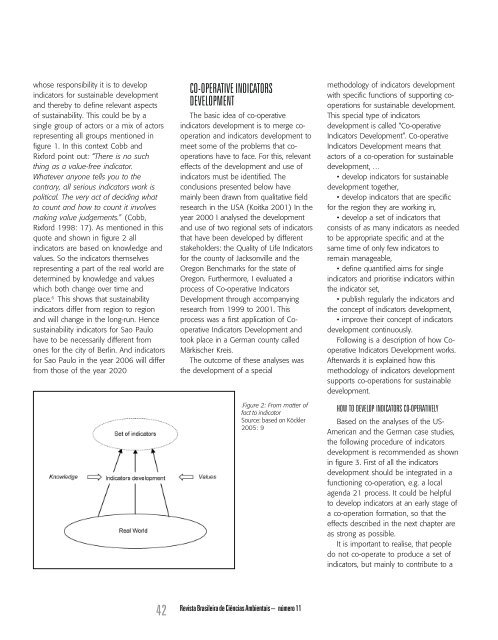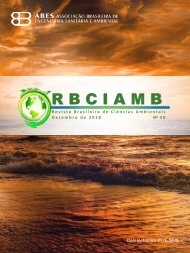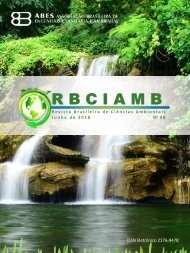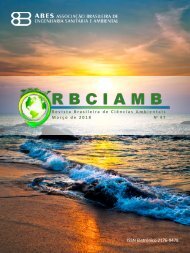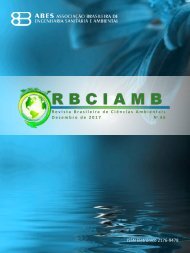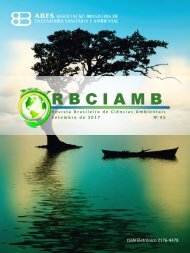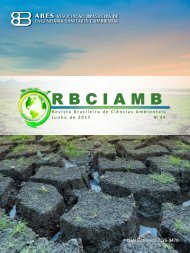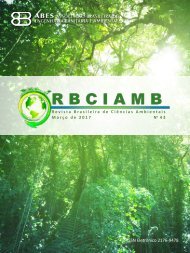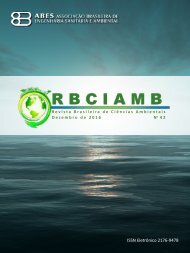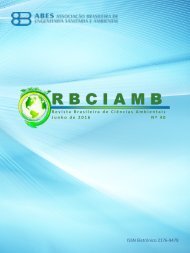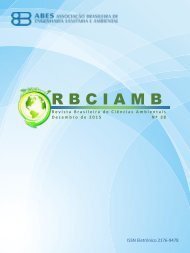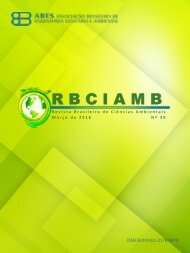EDIÇÃO 11 - Dezembro/08 - RBCIAMB
A Revista Brasileira de Ciências Ambientais – RBCIAMB - publica artigos completos de trabalhos científicos originais ou trabalhos de revisão com relevância para a área de Ciências Ambientais. A RBCIAMB prioriza artigos com perspectiva interdisciplinar. O foco central da revista é a discussão de problemáticas que se inscrevam na relação sociedade e natureza em sentido amplo, envolvendo aspectos ambientais em processos de desenvolvimento, tecnologias e conservação. A submissão dos trabalhos é de fluxo contínuo.
A Revista Brasileira de Ciências Ambientais – RBCIAMB - publica artigos completos de trabalhos científicos originais ou trabalhos de revisão com relevância para a área de Ciências Ambientais. A RBCIAMB prioriza artigos com perspectiva interdisciplinar. O foco central da revista é a discussão de problemáticas que se inscrevam na relação sociedade e natureza em sentido amplo, envolvendo aspectos ambientais em processos de desenvolvimento, tecnologias e conservação. A submissão dos trabalhos é de fluxo contínuo.
Create successful ePaper yourself
Turn your PDF publications into a flip-book with our unique Google optimized e-Paper software.
whose responsibility it is to developindicators for sustainable developmentand thereby to define relevant aspectsof sustainability. This could be by asingle group of actors or a mix of actorsrepresenting all groups mentioned infigure 1. In this context Cobb andRixford point out: “There is no suchthing as a value-free indicator.Whatever anyone tells you to thecontrary, all serious indicators work ispolitical. The very act of deciding whatto count and how to count it involvesmaking value judgements.” (Cobb,Rixford 1998: 17). As mentioned in thisquote and shown in figure 2 allindicators are based on knowledge andvalues. So the indicators themselvesrepresenting a part of the real world aredetermined by knowledge and valueswhich both change over time andplace. 6 This shows that sustainabilityindicators differ from region to regionand will change in the long-run. Hencesustainability indicators for Sao Paulohave to be necessarily different fromones for the city of Berlin. And indicatorsfor Sao Paulo in the year 2006 will differfrom those of the year 2020CO-OPERATIVE INDICATORSDEVELOPMENTThe basic idea of co-operativeindicators development is to merge cooperationand indicators development tomeet some of the problems that cooperationshave to face. For this, relevanteffects of the development and use ofindicators must be identified. Theconclusions presented below havemainly been drawn from qualitative fieldresearch in the USA (Koitka 2001) In theyear 2000 I analysed the developmentand use of two regional sets of indicatorsthat have been developed by differentstakeholders: the Quality of Life Indicatorsfor the county of Jacksonville and theOregon Benchmarks for the state ofOregon. Furthermore, I evaluated aprocess of Co-operative IndicatorsDevelopment through accompanyingresearch from 1999 to 2001. Thisprocess was a first application of CooperativeIndicators Development andtook place in a German county calledMärkischer Kreis.The outcome of these analyses wasthe development of a special.Figure 2: From matter offact to indicatorSource: based on Köckler2005: 9methodology of indicators developmentwith specific functions of supporting cooperationsfor sustainable development.This special type of indicatorsdevelopment is called “Co-operativeIndicators Development”. Co-operativeIndicators Development means thatactors of a co-operation for sustainabledevelopment, …• develop indicators for sustainabledevelopment together,• develop indicators that are specificfor the region they are working in,• develop a set of indicators thatconsists of as many indicators as neededto be appropriate specific and at thesame time of only few indicators toremain manageable,• define quantified aims for singleindicators and prioritise indicators withinthe indicator set,• publish regularly the indicators andthe concept of indicators development,• improve their concept of indicatorsdevelopment continuously.Following is a description of how CooperativeIndicators Development works.Afterwards it is explained how thismethodology of indicators developmentsupports co-operations for sustainabledevelopment.HOW TO DEVELOP INDICATORS CO-OPERATIVELYBased on the analyses of the US-American and the German case studies,the following procedure of indicatorsdevelopment is recommended as shownin figure 3. First of all the indicatorsdevelopment should be integrated in afunctioning co-operation, e.g. a localagenda 21 process. It could be helpfulto develop indicators at an early stage ofa co-operation formation, so that theeffects described in the next chapter areas strong as possible.It is important to realise, that peopledo not co-operate to produce a set ofindicators, but mainly to contribute to a42Revista Brasileira de Ciências Ambientais – número <strong>11</strong>


